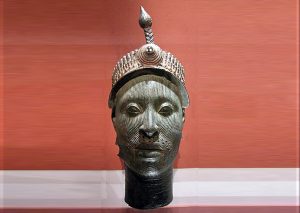
Image credit: YouTube
Carving is indeed considered a form of art that involves shaping or sculpting a material, typically by removing or subtracting portions of it, to create a desired form or design. This artistic technique has been practised for thousands of years and has been used to create intricate and detailed works across various cultures and mediums.
Carving can be done using a wide range of materials, including wood, stone, ivory, bone, metal, and even fruits and vegetables. Each material presents its unique challenges and possibilities, allowing artists to explore different textures, colours, and properties in their creations.

Types of Carving
Wood carving is one of the most common and traditional forms of carving. It involves using specialized tools such as chisels, knives, and gouges to shape and sculpt wood into desired forms. Woodcarvers can create anything from small figurines and intricate decorative pieces to large-scale sculptures and architectural elements.
Stone carving is another ancient form of carving that has produced some of the most iconic and enduring works of art throughout history. Sculptors carve stone by removing excess material with tools like chisels, hammers, and rasps. Marble, granite, limestone, and alabaster are commonly used stones for carving, each offering its unique qualities and challenges.
Other materials like ivory and bone have been used for carving in many cultures, particularly in the creation of intricate sculptures, figurines, and decorative items. These materials require specialized tools and techniques due to their hardness and density.
Metal carving, often referred to as engraving, involves removing layers of metal to create intricate patterns, designs, or images. It is commonly used in jewellery making, weapon embellishments, and ornamental objects.
Carving can also be seen in the art of culinary creations, where skilled chefs use knives and other tools to carve intricate designs on fruits, vegetables, and even ice sculptures.
Throughout history, carving has been employed in religious, cultural, and artistic contexts. It has been used to create statues, reliefs, architectural details, ornamental objects, and functional items. Carving allows artists to express their creativity, highlight their technical skills, and breathe life into inert materials by revealing the beauty within them.
Today, carving continues to be practised as a traditional art form, but it has also evolved to incorporate modern techniques and concepts. Contemporary artists often combine carving with other artistic disciplines, such as painting or mixed media, pushing the boundaries of what can be achieved through this versatile art form.
Carving in Nigeria
Carving holds a significant place in the artistic traditions of Nigeria, reflecting the rich cultural heritage and diverse ethnic groups found in the country. Nigerian carving encompasses various materials, including wood, stone, ivory, and bronze, each with its distinct styles and techniques.
Wood carving is one of the most prominent forms of carving in Nigeria. Skilled woodcarvers create intricate sculptures, masks, and ceremonial objects that are deeply rooted in the cultural and religious practices of different Nigerian tribes. Each ethnic group has its unique carving style and symbolism. For example, the Yoruba people are known for their elaborate and highly expressive wooden sculptures, while the Igbo people are renowned for their intricate wooden masks and figures.
The Ife and Benin Kingdoms of Nigeria have a rich history of bronze casting, which involves carving intricate wax models and then casting them in bronze using the lost-wax technique. These bronze sculptures often depict royal figures, deities, and significant historical events. The Benin bronzes, in particular, are celebrated for their exceptional craftsmanship and have gained international recognition.
Ivory carving is another traditional art form in Nigeria, although it has become less prevalent due to restrictions on the ivory trade. Historically, ivory was carved into intricate sculptures, jewellery, and functional objects. These carvings displayed great attention to detail and craftsmanship.
In addition to these traditional materials, contemporary Nigerian artists have also explored carving in unconventional materials and mixed-media approaches. For example, some artists combine wood carving with other materials like metal, glass, or fabric to create innovative and thought-provoking sculptures.
Carving in Nigeria not only serves as a means of artistic expression but also plays a vital role in preserving cultural heritage and passing down ancestral knowledge. Many carvers in Nigeria learn their craft through apprenticeships, ensuring the continuity of traditional techniques and styles.
Overall, carving in Nigeria is a dynamic and evolving art form that reflects the country’s diverse cultures, history, and artistic ingenuity. It continues to be celebrated and appreciated both within Nigeria and internationally as a unique expression of Nigerian artistic traditions.
Benefits of carving
Carving in Nigeria provides several benefits to the country, both culturally and economically. Here are some of the key benefits:
Preservation of Cultural Heritage: Carving plays a crucial role in preserving Nigeria’s rich cultural heritage. It allows for the continuation of traditional artistic practices, techniques, and styles that have been passed down through generations. Carvings often depict stories, religious beliefs, and historical events, serving as a visual representation of Nigerian culture and traditions.
Economic Empowerment: Carving has the potential to contribute to Nigeria’s economy by providing income and employment opportunities. Skilled carvers can sell their artworks locally and internationally, contributing to the country’s handicraft industry and tourism sector. Carving workshops and training programs can also create jobs and support the livelihoods of artisans and their communities.
Cultural Tourism: Carvings are sought-after cultural artefacts that attract tourists and art enthusiasts from around the world. Nigeria’s diverse carving traditions, such as Yoruba woodcarving, Igbo mask carving, and Benin bronze casting, can serve as significant attractions for cultural tourism. This can generate revenue for local communities and promote cultural exchange.
Artistic Expression and Identity: Carving allows Nigerian artists to express their creativity and explore their cultural identity. Through carving, artists can convey stories, emotions, and ideas unique to their experiences and traditions. This artistic expression strengthens a sense of identity and fosters cultural pride among Nigerians.
Skill Development and Empowerment: Learning the art of carving equips individuals with valuable skills, such as craftsmanship, attention to detail, and creativity. These skills can enhance personal development and provide opportunities for self-employment or participation in the wider creative industry. Carving workshops and training programs can empower individuals, especially young people, by equipping them with marketable skills.
Cultural Exchange and Dialogue: Carving can facilitate cultural exchange and dialogue both within Nigeria and with the international community. Art exhibitions, festivals, and collaborations enable artists to share their work, stories, and cultural perspectives, fostering mutual understanding and appreciation.
Artistic Innovation and Contemporary Expression
While carving in Nigeria has a strong foundation in traditional practices, it also provides a platform for artistic innovation and contemporary expression. Nigerian artists can blend traditional carving techniques with modern materials, concepts, and styles, pushing the boundaries of the art form and contributing to the global art scene.
In summary, carving in Nigeria brings forth cultural preservation, economic opportunities, tourism potential, artistic expression, skill development, and cultural exchange. It is a valuable and multifaceted art form that contributes to Nigeria’s cultural landscape and socio-economic development.
What’s your impression about this story.
Kindly like and share





















